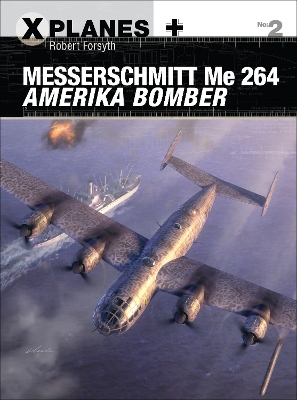X-Planes
4 primary works
Book 2
As Europe plunged into World War II, Hitler ordered the development of a hi-tech secret weapon capable of taking the war across the Atlantic - the Messerschmitt Me 264. Chosen from designs for an 'Amerika Bomber' tendered by Messerschmitt, Junkers and Focke-Wulf, this ultra-long-range aircraft would be capable of attacking cities in the United States. Just one month before the attack on Pearl Harbor and the American entry into World War II Hitler was promising, privately, to wage a 'new war' against the USA after his victories in Europe. Dazzling digital artwork and 50 rare archive photographs perfectly complement the detailed analysis offered by Robert Forsyth as he examines the development, intended role and influence of the aircraft that Hitler planned to use to bomb New York City.
Book 4
In late 1944, the German Air Ministry organised what it called an 'Emergency Fighter Competition' intended to produce designs for quick-to-build yet technically and tactically effective jet fighter aircraft capable of tackling the anticipated arrival of the B-29 Superfortress over Europe, as well as the British Mosquito and US P-38 Lightning which were appearing in ever greater numbers.
Thus was born a cutting-edge, highly sophisticated series of aircraft including the futuristic and elegant Focke-Wulf Ta 183; the extraordinary Blohm und Voss P.212, and the state-of-the-art Messerschmitt P.1101 series. Armed with heavy cannon and the latest air-to-air rockets and missiles, these were designed to inflict carnage on American bomber formations at high speed. Using stunning three-view illustrations of each prototype along with full colour artwork, aviation expert Robert Forsyth traces the history of the extraordinary aircraft of the 'Emergency Fighter Competition', Hitler's last throw of the dice in the air war against the Allies.
Thus was born a cutting-edge, highly sophisticated series of aircraft including the futuristic and elegant Focke-Wulf Ta 183; the extraordinary Blohm und Voss P.212, and the state-of-the-art Messerschmitt P.1101 series. Armed with heavy cannon and the latest air-to-air rockets and missiles, these were designed to inflict carnage on American bomber formations at high speed. Using stunning three-view illustrations of each prototype along with full colour artwork, aviation expert Robert Forsyth traces the history of the extraordinary aircraft of the 'Emergency Fighter Competition', Hitler's last throw of the dice in the air war against the Allies.
Book 8
The Bachem Ba 349 Natter was a secretive, vertical take-off, single-seat rocket interceptor intended to offer high-speed defence of key targets. This radical aircraft offered Luftwaffe an inexpensive means with which to intercept and attack Allied heavy bombers using a vertically-launched, semi-expendable machine built of wood and armed with a nose-mounted 'honeycomb' battery of spin-stabilised air-to-air rockets as well as cannon armament. Launched vertically at 36,000ft per minute, the pilot was expected to fly within range of the enemy bombers, fire his rockets at them, ram another bomber, eject and parachute to the ground.
Illustrated with contemporary photographs and stunning commissioned artwork, this study examines this inventive yet ultimately unsuccessful attempt by the Luftwaffe to defend against the tide of Allied aircraft that was bombing German cities into the ground.
Illustrated with contemporary photographs and stunning commissioned artwork, this study examines this inventive yet ultimately unsuccessful attempt by the Luftwaffe to defend against the tide of Allied aircraft that was bombing German cities into the ground.
Book 9
The Dornier Do 335 was conceived as a high-speed, all-weather fighter, and represented the pinnacle of piston-engined aircraft design. The Do 335 was a big aircraft, weighing just over 10,000kg when laden with fuel, equipment, and pilot, yet powered by two Daimler-Benz DB 603 engines, it was capable of reaching a maximum speed of 750km/h at 6400 meters, making it the fastest piston engine aircraft produced in Germany during World War II.
Some forty aircraft were built between late 1943 and the end of the war, and it was intended to deploy the type as a day fighter, bomber, night fighter, bad weather interceptor, and reconnaissance aircraft, all of which were intended to incorporate the latest armament, bomb sights, communications, and radar equipment, as well as an ejector seat. Featuring archive photography and specially commissioned artwork, this is the full story of the aircraft that the Luftwaffe hoped would turn the tide of the war.
Some forty aircraft were built between late 1943 and the end of the war, and it was intended to deploy the type as a day fighter, bomber, night fighter, bad weather interceptor, and reconnaissance aircraft, all of which were intended to incorporate the latest armament, bomb sights, communications, and radar equipment, as well as an ejector seat. Featuring archive photography and specially commissioned artwork, this is the full story of the aircraft that the Luftwaffe hoped would turn the tide of the war.



